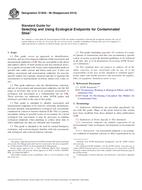Potřebujeme váš souhlas k využití jednotlivých dat, aby se vám mimo jiné mohly ukazovat informace týkající se vašich zájmů. Souhlas udělíte kliknutím na tlačítko „OK“.
ASTM E1848-96(2014)
Standard Guide for Selecting and Using Ecological Endpoints for Contaminated Sites
Automaticky přeložený název:
Standardní Guide pro výběr a použití ekologických parametrů pro kontaminovaných míst
NORMA vydána dne 1.1.2014
Informace o normě:
Označení normy: ASTM E1848-96(2014)
Poznámka: NEPLATNÁ
Datum vydání normy: 1.1.2014
Kód zboží: NS-43297
Počet stran: 10
Přibližná hmotnost: 30 g (0.07 liber)
Země: Americká technická norma
Kategorie: Technické normy ASTM
Kategorie - podobné normy:
Anotace textu normy ASTM E1848-96(2014) :
Keywords:
assessment endpoint, measurement endpoint, ICS Number Code 13.020.40 (Pollution, pollution control and conservation)
Doplňující informace
| Significance and Use | ||||
|
4.1 This guide assumes that a decision has been made that an ecological risk assessment is required for a contaminated site. In some cases, this decision could be made before any site data are collected. 4.2 The selection of assessment endpoints (defined as ecological values to be protected) and measurement endpoints (ecological characteristics related to the assessment endpoints) is a critical step in conducting an ecological risk assessment. Endpoint selection identifies those effects which are ecologically significant and not merely those that are adverse, thus providing a more rational and defensible basis for making risk and remedial decisions. 4.3 This guide provides an approach for identifying, selecting and using assessment and measurement endpoints in an ecological risk assessment for a contaminated site. This guide has been developed because there is no universal, simple measure of ecological health analogous to measures used in human health risk assessment. Assessment and measurement endpoints have to be identified and selected from a variety of individual circumstances on a stressor-, ecosystem- and scale-specific basis. It is important to recognize that a diverse set of ecological endpoints could be required for a specific site. 4.4 This guide is intended to be used primarily by a biologist, ecologist, ecotoxicologist, or a team of environmental scientists during problem formulation and work plan development prior to initiating data collection activities at a contaminated site (3-8, 10). 4.5 Ecological risk assessment is usually an iterative process. In many circumstances it proceeds as a series of tiers, that is, desktop/screening, preliminary, and detailed/focused phases. This guide can be used to refine or modify assessment and measurement endpoints developed in earlier phases of the process. 4.6 This guide can be used whenever assessment and measurement endpoints must be identified and selected following an initial or preliminary problem formulation/planning phase: 4.6.1 Analysis phase (exposure assessment, hazard/effects assessment, stress/dose-response assessment; 4.6.2 Risk characterization phase; or 4.6.3 Remediation phase and possible subsequent ecological monitoring. 4.7 This guide is intended to be used in the evaluation of baseline conditions (current and future) and in the evaluation of conditions resulting from remedial actions or corrective measures. |
||||
| 1. Scope | ||||
|
1.1 This guide covers an approach to identification, selection, and use of ecological endpoints (both assessment and measurement endpoints) (1-8)2 that are susceptible to the direct and indirect effects of both chemical and non-chemical stressors or agents associated with wastes and contaminated media at specific sites under current and future land uses. It does not address assessment and measurement endpoints for non-site specific studies (for example, chemical-specific or regional risk assessments) or measurements in abiotic media (soil, water, or air). 1.2 This guide addresses only the identification, selection, and use of assessment and measurement endpoints, not the full range of activities that occur in an ecological assessment or ecological risk assessment at a contaminated site 1.3 This guide is intended to identify assessment and measurement endpoints to be used for screening, preliminary, focused, detailed, and quantitative ecological risk assessments conducted in a linear or iterative fashion 1.4 This guide is intended to be used by trained biologists, ecologists, and ecotoxicologists familiar with risk assessment, and ecological and ecotoxicological concepts. 1.5 This guide (including 1.6 This standard does not purport to address all of the safety concerns, if any, associated with its use. It is the responsibility of the user of this standard to establish appropriate safety and health practices and determine the applicability of regulatory limitations prior to use. |
||||
| 2. Referenced Documents | ||||
|
Doporučujeme:
Aktualizace technických norem
Chcete mít jistotu, že používáte pouze platné technické normy?
Nabízíme Vám řešení, které Vám zajistí měsíční přehled o aktuálnosti norem, které používáte.
Chcete vědět více informací? Podívejte se na tuto stránku.




 Cookies
Cookies
